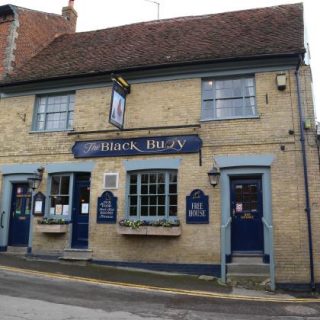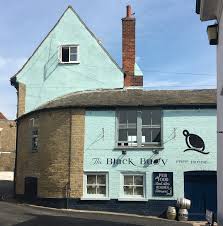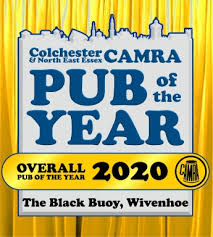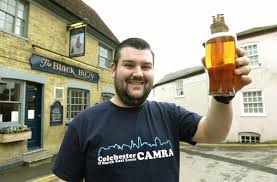About The Black Buoy (formerly The Black Boy) - late 16th century to the present day
This pub is located on Black Buoy Hill, Wivenhoe, CO7 9BS
Gill Strudwick
The Pub Trail Index – click here
The Black Buoy is thought to be the oldest pub in Wivenhoe. It was originally called The Black Boy but its name was changed to The Black Buoy in 1912.
How did it get its name?
It was originally called The Black Boy possibly so named after Charles II who, with his black hair and dark complexion, was popularly referred to as ‘The Black Boy’, or possibly perhaps referring to a black servant, or a black-coated coach boy. Now The Black Buoy is associated with the River Colne nearby. Auction records show that the pub was referred to as The Black Boy to at least as late as 1899/1900 (ES, Sat 9 Sept.1899). It is thought the name was changed to ‘The Black Buoy’ in 1912 when Captain William Ennew was landlord.
Early History
It is a Grade II listed building, possibly dating from the late 16th century (NHLE entry number 1225214). It was noted for its gault (yellow) brick frontage and peg-tiled roof, but these features hide a much older wooden building. It is in the Conservation Area of lower Wivenhoe, just behind the popular Quay and the River Colne. In the early 19th century it was owned by Thomas Harvey, the ship builder. Many sailors, tradesmen and even smugglers drank here. It was thought there was a smuggler’s tunnel leading from the pub to the quay but there is no evidence of this today. Wivenhoe boats were engaged in smuggling rum, gin and other spirits.
Landlords
The earliest record we have found for a landlord was in 1732 – John Howes (possibly spelt Hawes). In the late 1800s, the Goodwin family were landlords for over 30 years. In the 1900s, Charles Sainty was one of the longest serving landlords, and after a period of several changes, Reg Blackwell and his wife Jean took over in 1979 and were the landlords for over 15 years.
Read more about the life of Reg and Jan Blackwell at the pub in the link below.
Later History
From 1855 to 1935 The Black Buoy ran two ledgers ‘Prosperous’ and ‘Durrells’ for recording payments made to the pub by people for their medical treatment at the doctors.
From around 1925, the Wivenhoe Sailing Club met there for meetings and social occasions before they built their clubhouse on the old Hard, at the bottom of Anchor Hill. Dr Walter Radcliffe and Lewis Worsp, after one of these meetings, decided to design a Wivenhoe One Design racing dinghy, so that all the boats in a race would be equal.
In the 1960s, it became one of several pubs where artists gathered, and the photograph shows them outside The Black Buoy. These artists together with the help of George Gale founded the Wivenhoe Arts Club/Centre which was situated in the stables and coach house on Ballast Quay Road
Read more about the Arts Club in the link below.
In 1964 it started to become popular with people from Essex University, which had just been opened.
In response to competition and changing lifestyles, The Black Buoy decided to stop serving their popular baked potatoes and diversified into serving Balti food which proved very successful and in 1994 it won the BBC Essex Pub of the Week (ERO SA1/1193/1 Balti Food and Smugglers Tales).
Difficult Times
There were several difficult times for the pub during its history, particularly during the 1930s and early 1940s and then again in the late 1990s and 2000’s when landlords changed quite frequently. During this time the pub was tied to the brewery Daniell & Sons, then Truman’s Brewery and later Pubmaster. In 2012 the pub was closed and put up for sale. In November 2013 it opened once again,
New beginnings
In 2013 the pub was saved from closure and bought by a group of local residents and run as a community pub. That is when it was completely refurbished and given an attractive outside seating area. It became a free house, and is now a very popular pub that also serves good food.
Read more about the story of the refurbishment in 2013 in the link below.
From the photograph you can see that the pub used to have three doors at the front but now has only two doors that open, one leading to the bar and the other to the new B & B rooms upstairs. The design of the interior has been changed several times over the years. It is now a traditional pub, with a good selection of local and craft beers. It was the N.E.Essex CAMRA Rural Pub of the Year for six years running and in 2020 the pub was again awarded Overall Rural Pub of the Year.
In recent years the pub has aimed to support the local community with fund raising for different causes.
Behind the pub is thought to be the site of The Sun pub but the only indication now is Sun Yard, as most of the properties here were demolished in the 1930s.
Links to other pages on this website:
- About Thomas Corder Goodwin, landlord of The Black Boy for 30 years from 1866 to 1896
- About Medical and Benefits Clubs run at local pubs in the 1800s
- About Reg & Jean Blackwell, landlords of The Black Buoy from 1979 to 1995
- Wivenhoe Arts Club/Centre – Pat Marsden
- The Story of the re-furbishment in 2013, Carol Macaskill 2020
- Artists at the Black Buoy
- Art work on display in The Black Buoy in 2020
- Auctions at the Black Boy Inn in the 1800s
- Landlords and Breweries of the Wivenhoe pubs
References:
- ES: Essex Standard (newspaper), Colchester, England.
- ERO: Essex Record Office
- NHLE: National Heritage List of England https://historicengland.org.uk/
General Sources:
- Black Buoy website: www.blackbuoy.co.uk/
- Butler N, “The Story of Wivenhoe”, Quentin Press Wivenhoe, 1989.
- Kay P, “Wivenhoe Pubs”, published by Peter Kay 2003
The Pub Trail Index – click here













No Comments
Add a comment about this page